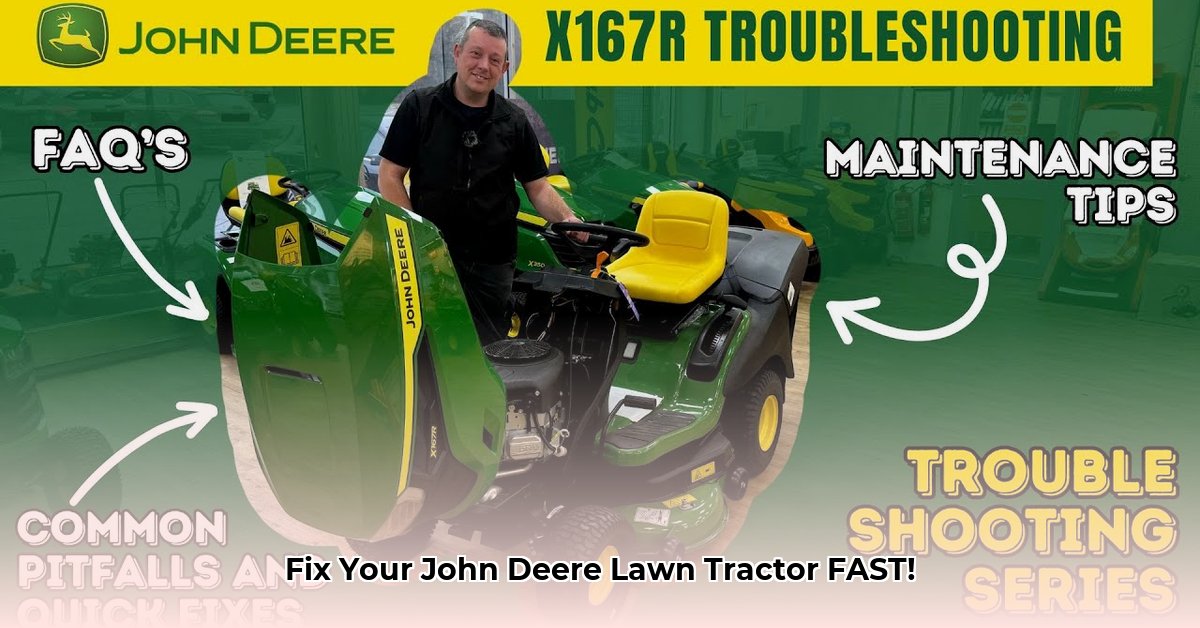
Let's face it: even a reliable John Deere lawn tractor can experience problems. This guide provides step-by-step troubleshooting for common issues, empowering you to fix minor problems yourself and avoid costly repairs. We'll cover starting issues, engine troubles, cutting deck problems, and preventative maintenance – all with clear instructions and safety tips. For more specific starting issues, see our John Deere troubleshooting guide.
Starting Troubles: Why Won't My John Deere Start?
A lawn tractor that won't start is frustrating. Before panicking, let's check the basics: Is the fuel tank full? Is the battery charged? A simple jump start might suffice. If not, let's troubleshoot:
Step 1: Check the Fuel Line for Blockages. Inspect the fuel line (the tube carrying gas to the engine) for any debris or kinks. A small blockage can prevent fuel flow. Compressed air can sometimes clear minor clogs.
Step 2: Inspect the Spark Plug. The spark plug ignites the fuel-air mixture. A fouled (dirty) or damaged spark plug prevents starting. Visually inspect it; if it's dirty or damaged, replace it (easily found at most hardware stores). Always disconnect the spark plug wire before handling the spark plug to avoid electric shock.
Step 3: Examine the Ignition Switch. This switch controls power to the engine. A faulty switch can prevent starting. Try cleaning it or gently tapping it; replacement might be necessary if it's damaged.
Step 4: Clean and Secure the Battery Terminals. Corrosion on battery terminals hinders electrical flow. Use a wire brush or terminal cleaner to remove corrosion, ensuring tight connections.
If these steps fail, consult your owner's manual or a qualified mechanic.
Engine Problems: My John Deere is Running Rough
A sputtering, smoking, or poorly performing engine needs attention. Regular maintenance is crucial: Are your oil changes and air filter replacements up-to-date?
Step 1: Check the Oil Level. Low oil leads to engine damage. Check the oil level (consult your owner's manual) and add oil if necessary. Never overfill.
Step 2: Check the Air Filter. A clogged air filter restricts airflow, harming engine performance. If dirty, clean or replace it (instructions are in your owner's manual).
Step 3: Inspect the Fuel Filter. A dirty fuel filter restricts fuel flow. Replacing it is relatively easy and often dramatically improves performance.
Step 4: Consider the Carburetor (if applicable). Carburetor issues often require professional help, as cleaning or adjustment is complex.
Addressing engine problems promptly is key to preventing major repairs.
Cutting Deck Woes: Uneven Cuts and Dull Blades
Uneven cuts or torn grass usually indicate a cutting deck problem.
Step 1: Inspect the Blades. Dull or damaged blades are the most common cause. Sharpen or replace them (always disconnect the spark plug before working on the cutting deck!).
Step 2: Adjust the Blade Height. Incorrect blade height leads to uneven cuts. Consult your owner's manual for adjustment instructions.
Step 3: Check the Drive Belt. A worn drive belt prevents proper blade rotation. Inspect it for wear; replace if needed.
Step 4: Lubricate Moving Parts. Regular lubrication reduces friction and prolongs component life. Use the appropriate lubricant specified in your owner's manual.
Preventative Maintenance: Your Best Tool
Preventative maintenance extends your tractor's lifespan. Regular checks prevent minor problems from becoming major headaches.
| Task | Frequency | Importance |
|---|---|---|
| Oil Change | Every 50 hours (or as recommended) | Prevents engine wear and prolongs engine life. |
| Air Filter Cleaning/Change | Every 25 hours (or as recommended) | Ensures proper engine combustion and performance. |
| Blade Sharpening | Every 10 hours (or as needed) | Maintains clean, even cuts and prevents blade damage. |
| Fuel Filter Inspection | Every 50 hours (or as recommended) | Prevents fuel system clogs and ensures consistent fuel delivery. |
| Battery Inspection | Monthly | Prevents starting issues and ensures battery health. |
| Deck Lubrication | Every 25 hours (or as recommended) | Prevents wear and tear on moving parts. |
A regular maintenance schedule saves you money and frustration in the long run.
Fuel System Issues: Ethanol and Other Problems
Ethanol in gasoline can corrode fuel system components over time. Using a fuel stabilizer, especially during periods of inactivity, is a smart preventative measure.
Overheating: Keeping Your John Deere Cool
Overheating is serious; it can be caused by low oil, a clogged cooling system, or operating in extreme heat. Regularly check coolant levels and ensure adequate airflow around the engine.
By combining regular maintenance with this troubleshooting guide, you can keep your John Deere lawn tractor running smoothly for years to come. Remember, preventative care is key!